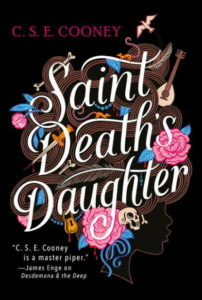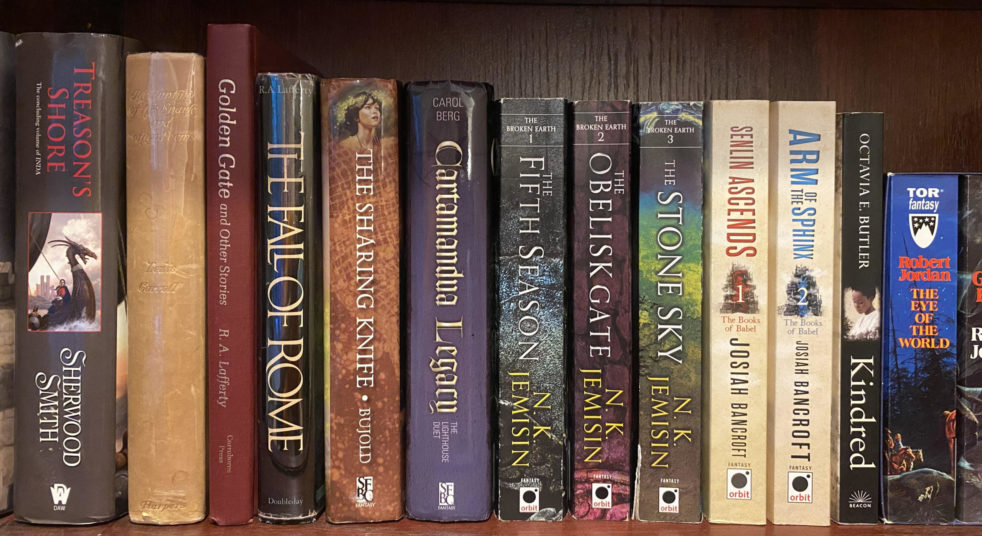
The marketing of C.S.E. Cooney’s Saint Death’s Daughter did absolutely nothing to appeal to me. Queer coming-of-age? Could be good, but not a selling point in itself. Features necromancers? That’s probably a negative, to be honest. Comparisons to Gideon the Ninth? Absolutely a negative. But enough bookish friends liked it that I decided to give it a shot. And guess what? It’s excellent.
Saint Death’s Daughter stars Miscellaneous “Lanie” Stones, a young necromancer with an allergy to violence, born to an assassin and an executioner. After the death of her parents, she finds herself perhaps the only one who can keep her remaining family clear of both their creditors and the foreign powers seeking vengeance for the acts of her relatives.
Because I found myself so misled by the marketing, I can’t start my thoughts on the story anywhere else than an attempt to clear up any confusion others may have. Despite necromancers, queer characters, and amusing footnotes, this has both a different tone and generally different aims than Gideon the Ninth. And while the lead is in her teens and 20s for most of the book, it’s only partially a coming-of-age story, with the coming-of-age arc focused in particular on Lanie coming to terms with her necromancy and the extremely complicated family legacy that comes with it.
Instead, it’s a story about magic, about family, and about legacy. Lanie’s sense of humor seasons an otherwise gloomy narrative with a fair bit of levity, with footnotes keeping a running tally of Stones family names and increasingly absurd ways for them to die young. But this is not a comic fantasy. In fact, it’s much closer to an epic fantasy. Lanie’s family has won wars with their magic, and they’ve enslaved devotees of other gods. The story may start with literal creditors coming to collect, but there are both geopolitical and magical consequences to her family’s actions that Lanie must find a way to put right—or, if not entirely right, at least right enough to save her own skin, and the skins of her few remaining relatives.
So much for what it’s about. Is it good though? Yes, of course it is, I said that up front. The narrative voice is truly fantastic, with a prose style that’s beautiful without being opaque, funny without being frivolous, earnest without being depressing. And the story does an exceptional job of interrogating all the little details of a complicated legacy without resorting to a rebel lead who simply abandons her family. Instead, the narrative is deeply rooted in family and personal relationships, with thorny questions of how to deal with the ongoing fallout from past wrongs providing a source of conflict without being an impetus to just abandon all familial responsibility.
And beyond all that, it’s a really entertaining central story. With so much focus on the small, personal details, it takes a while for the central narrative to really take shape, but when it does, it’s exciting, and it’s epic. And the little personal moments leading up to that epic plot create a compelling lead to build it around, with plenty of intermediate climaxes to let off tension along the way. It is a very long book, and the pacing may be slower than some prefer, but for fans of epic fantasy, that’s hardly a deal-breaker. And while it does leave one unresolved subplot to dangle awaiting a sequel, the main story comes together well enough to make it a satisfying standalone.
If I had to pick a favorite novel of 2022, it would be really tough to beat Saint Death’s Daughter. Its thematic depth, outstanding narrative voice, and fascinating interpersonal relationships make it stand out, even in comparison with some of the best works of the year. A slow-developing main arc and an unresolved subplot may be minor annoyances, but there’s just not much to criticize here–it’s an excellent book.
Recommended if you like: single-POV epic fantasy, excellent prose.
Can I use it for Bingo? It’s hard mode for Queernorm Setting and is also a Book Club Book.
Overall rating: 18 of Tar Vol’s 20. Five stars on Goodreads.
